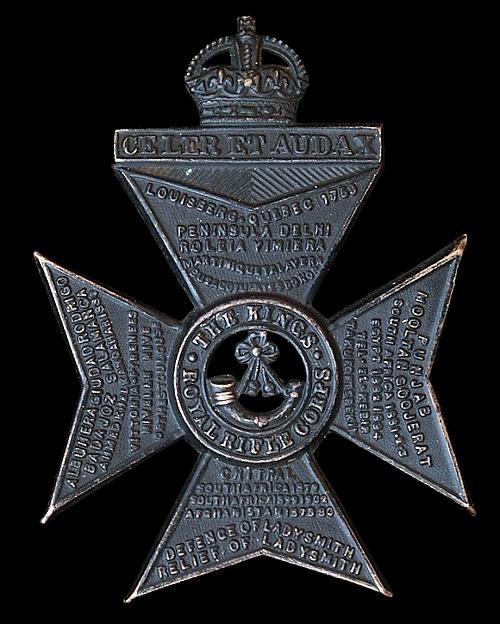
Percy Whiting

11th Battalion
Rifleman R/3725
 | Percy Whiting |  |
| King's Royal Rifle Corps 11th Battalion Rifleman R/3725 | ||
| Killed 17th September 1916 |
Percy Whiting's Parents | ||
|
Percy’s father was William James Whiting, who was born in Bath in 1872 and brought up in Paradise Street, which used to run from Holloway down to the Wells Rd (this whole area was cleared and redeveloped in the early 1970s). The houses were by no means large, but the 1881 census shows William as one of six siblings living with his parents (Abel & Elizabeth), plus his widowed grandmother, two uncles and an aunt. Abel & Elizabeth (Percy’s grandparents), were involved in a ‘double wedding’ at Widcombe Old Church (Thomas a Becket) in 1868, where Elizabeth’s eldest sister Jane was also married to a Mr Charles Cottle. | ||
 | ||
|
Paradise Street as seen circa 1970, prior to redevelopment. Home to William Whiting, Percy's father. The houses in the distance, facing the camera, are still there in Wells Road [Image: Bath In Time} |
|
In 1891, Percy's father William was a 19-year-old ‘paperhanger’, which refers to the hanging of wallpaper, i.e. a decorator. Bath was undergoing a housing boom at this time, as people flocked to the cities for work and large areas of housing (such as the spread of ‘Twerton’ towards the boundary with Bath) sprang up to accommodate them. So there was plenty of work available in the building and decorating trades. By now, William was one of 11 siblings living at home in Paradise Street with his parents, who produced 13 children in total. Percy’s mother, Alice Jane Dando, was also from a large family and one of at least 12 children born into the family of a coal miner in Chilcompton. The 'Dando' name is largely peculiar to northern Somerset. Alice was born in 1873 when the family lived at ‘Norton Down Buildings’ and she spent her childhood here. In 1891, at the age of 18, the census shows Alice in service in Bath, with the Vizard family at 6 North Parade. The head of the household was Mr Worthy Vizard, artist and portrait painter, who regularly advertised his services and goods in the Bath Chronicle and Weekly Gazette. He imported paintings from Italy at a time when Italy was very much the focus of fashionable tastes and an interest in Italian arts was much lauded among polite society. Vizard’s premises at 6 North Parade (on the corner with Pierrepont St) are now occupied by ‘Good Buy Books’, so he had good window space in which to display his paintings. He was so successful that he later also opened a gallery at 35 Milsom St (now Gabucci clothing shop). |
The Whiting Family |
|
William and Alice were married in the early part of 1895 at St Augustine’s church in Clutton and Percy was born in December of the same year. |
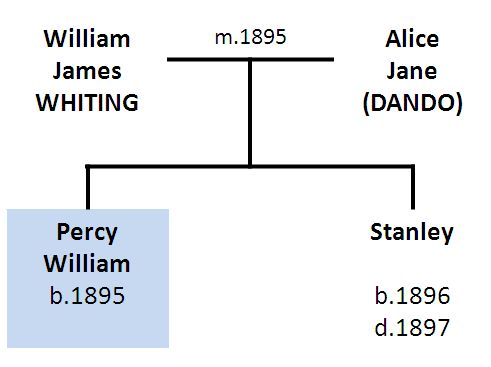 |
|
The Bath Directories show Percy’s father William listed from 1892 as a wheelwright &
timber dealer, operating from 18 Westgate Buildings (in a section of Westgate
Buildings now demolished) and later also ‘Pickwick Mews’ in Avon Street (also demolished). Percy’s only
sibling – a younger brother called Stanley – was born in 1896. Stanley did not
survive until his first birthday, dying early in 1897, but he did outlive
Alice, who died (aged just 23) in 1896, leaving Percy without a mother. Worse was yet to come, as Percy’s father also died (aged 28) in
1899, leaving Percy an orphan at the
age of four. Percy then went
to live with his grandparents, Abel & Elizabeth Whiting, who had moved from
Paradise Street to 19 Millmead Road. |
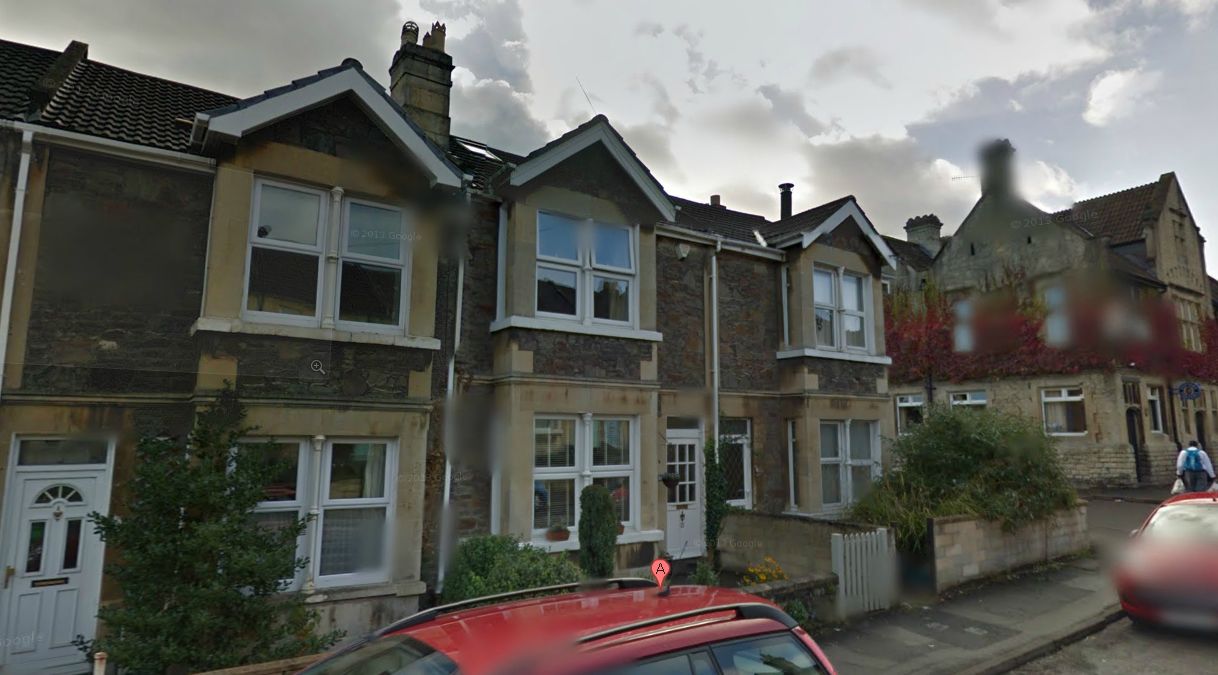 | ||
|
19 Millmead Road, three doors down from the Victoria Inn and on the far left of this picture, where the orphaned
Percy Whiting went to live with his grandparents in 1899. |
|
The move to his grandparents’ family in Millmead Road
brought Percy into the catchment
area for South Twerton School just at the time when he would have been
beginning schooling, at about the age of five, although we know from reports of
annual school prize-givings that Percy
was in Standard II in 1904 and Standard III in 1905, so he may not have begun
attending until 1902-3. Percy’s
grandmother Elizabeth died in 1906 and his grandfather moved several times
between addresses in Herbert Road, St Kilda’s Road and Sladebrook Avenue over
the next few years; we can only assume that Percy stayed with him in that time. Abel was listed in The Bath
Directory at 10 Sladebrook Avenue in 1910. In 1911, however, Percy’s youngest aunt, Gertrude,
married John Giles and the 1911 census shows them living at 10 Sladebrook
Avenue – with Percy – while grandfather Abel had gone to number 16 to live with
his daughter Eleanor (by then married and called Smallbone) with her husband
and two children. |
|
Sladebrook Avenue early in the 20th century. Number 10
(where Percy lived with his grandfather, then with his aunt Gertrude) is out of
view on the right-hand side. |
|
The 1911 census also reveals that Percy, aged 15, was working as a ‘jobbing gardener’s assistant’. This is the
last we know of Percy before the war
in 1914. |
Percy Whiting in WW1 | ||
King's Royal Rifles
Percy signed up with the 11th Battalion of the King’s Royal Rifles on 7th September 1914 in Barry, South Wales. His 1914 attestation document when joining up shows a very loose grip on geography, stating that he was born in the parish of ‘Bath’, in or near the town of ‘Bristol’ in the county of ‘Glamorgan’! (It should have read ‘Bath’, ‘Bath’, ‘Somerset’.) The 11th (Service) Battalion of the King’s Royal Rifles was formed at Winchester in September 1914 as part of the ‘K2’ section of Kitchener’s New Army and came under orders of 59th Brigade in 20th (Light) Division. “Early days were somewhat chaotic, the new volunteers having very few trained officers and NCOs to command them, no organised billets or equipment. The units of the Division first assembled in the Aldershot area with brigades at Blackdown [now Princess Royal Barracks, Deepcut] and Cowshott. Artillery was particularly hard to come by; twelve old guns arrived from India in February 1915! When in the same month the Division moved to Witley, Godalming and Guildford, the artillery had to go by train as there was insufficient harness for the horses. Another move was made, to [Larkhill Camp on] Salisbury Plain in April 1915. The Division was inspected by King George V at Knighton Down on 24 June 1915, by which time all equipment had arrived and the Division was judged ready for war.” [Source: http://www.1914-1918.net/20div.htm] On 21st July 1915 the 20th Division landed at Boulogne and began to see action on the Western Front. Between the 2nd and the 17th August 1915 all units of the 20th Division were attached to the 8th and 27th Divisions in the line to introduce the officers and men to the realities of trench warfare and the 20th Division then at the end of the month took over the line south of that held by the 8th Division in the flat lands north of Neuve Chapelle. [Source: http://www.ww1wargraves.co.uk/ww1_cemeteries/ww1_cemeteries_f.asp] There was involvement in the Battle of Loos in September 1915, after which the remainder of 1915 was fairly quiet. The 20th Division remained in the Laventie sector until the 20th January 1916 when it was ordered North to join the Second Army. [Source: http://www.ww1wargraves.co.uk/ww1_cemeteries/ww1_cemeteries_f.asp]
The history of World War 1 in 1916 is dominated by the Battle of the Somme and Percy would have seen much of the action at first hand. This included The Battle of Mount Sorrel (a battle for the high ground overlooking the Ypres salient, June), The Battle of Delville Wood (part of the scramble for advantageous geographical features in the growing stalemate of the Battle of the Somme and famous for the disastrous casualties suffered by South African infantry, 14th July – 3rd September) and The Battle of Guillemont (3rd-6th September). | ||
Percy Whiting's Death at Flers-Courcelette | ||
|
Percy last saw action at Flers-Courcelette. From Wikipedia: “Launched on 15th September 1916 the battle went on for one week. Flers-Courcelette began with the objective of cutting a hole in the German line by using massed artillery and infantry attacks. This hole would then be exploited with the use of cavalry. It was the third and final general offensive mounted by the British Army during the Battle of the Somme. By its conclusion on 22 September, the strategic objective of a breakthrough had not been achieved; however tactical gains were made in the capture of the villages of Courcelette, Martinpuich and Flers. In some places, the front lines were advanced by over 2,500 yards (2,300 m) by the Allied attacks. “The battle is significant for the first use of the tank in warfare. It also marked the debut of the Canadian and New Zealand Divisions on the Somme battlefield.” The tanks introduced at Flers-Courcelette employed a long rhomboid shape which allowed the vehicle to traverse difficult terrain and to cross trenches. A pair of wheels at the back served as a steering mechanism. | ||
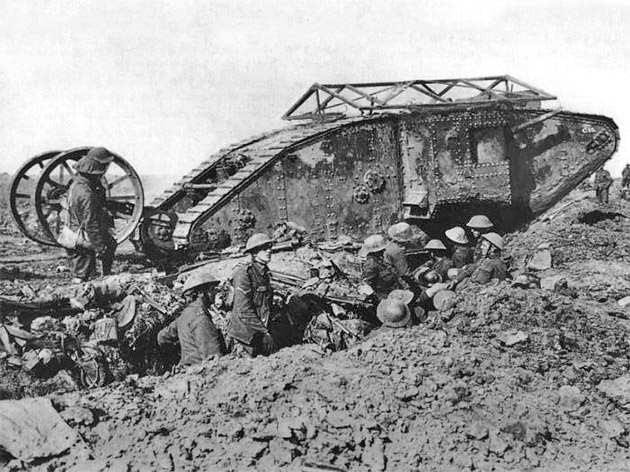 | ||
|
A tank preparing to advance at Flers-Courcelette; the first ever use of tanks in warfare. [Source: John Warwick Brooke [Public domain], via Wikimedia Commons] |
|
Rifleman Percy Whiting would therefore have witnessed the debut of the armoured tank at first hand but was killed in action on the third day of this Battle, the 17th Sept 1916: The 11th Battalion were given an impossible task on false information and with negligible artillery support. Their objective near Les Boeufs was at right angles to the line they had just taken over. They reached the enemy's trenches, but had to withdraw owing to the failure of other units to advance. Losses: Officers: killed 1, wounded 5; Other Ranks: 107
|
Decoration | ||
|
Percy Whiting would have been awarded the 1914-15 Star, the British War Medal 1914-18 and the Allied Victory Medal. posthumously | ||
 | 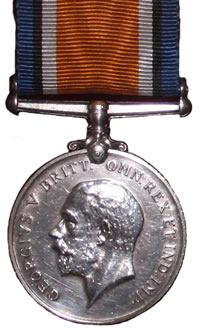 |  | ||
| 1914-15 Star | British War Medal 1914-18 | Allied Victory Medal |
Commemoration | ||
 In addition to his commemoration on the South Twerton School memorial, Rifleman Percy Whiting is commemorated as follows: | ||
|
Thiepval The Thiepval Memorial commemorates those who died with no
known grave in the battles of the Somme. It is the largest British battle
memorial in the world. A large inscription on an internal surface of the
memorial reads: |
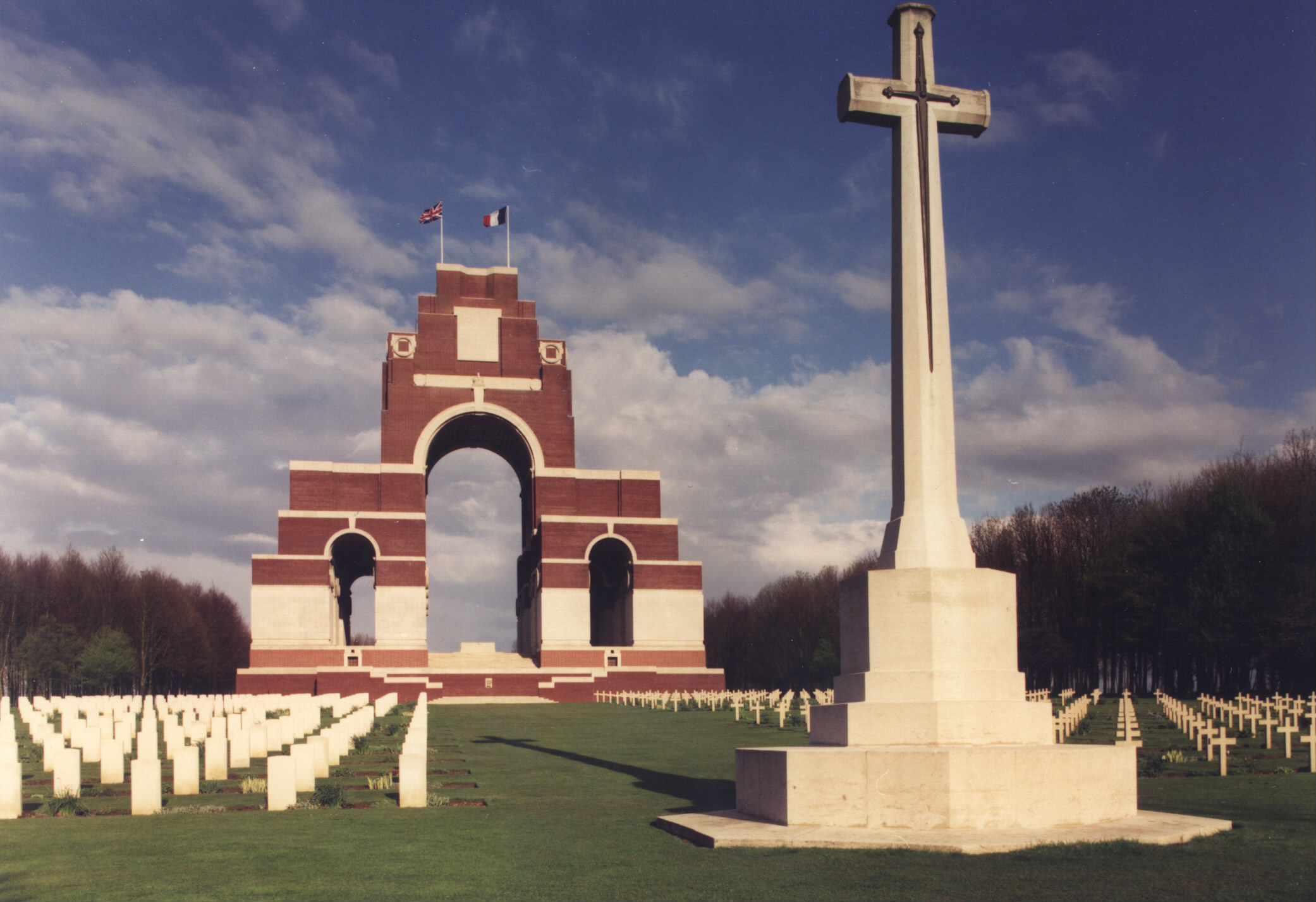 | ||
|
The Thiepval Memorial, where Percy
Whiting is commemorated, along with Harold Carless, who died on the same
day; George Collins and Percy Ware are also commemorated here. |
|
In July 2016, Mike & Kathy Sumsion of Bath
visited the Thiepval Memorial and made an especial search for the
inscription for Percy Whiting and other South Twerton men. As well as
contributing to the ongoing remembrance of Percy Whiting, they also
sent back the following photographs: |
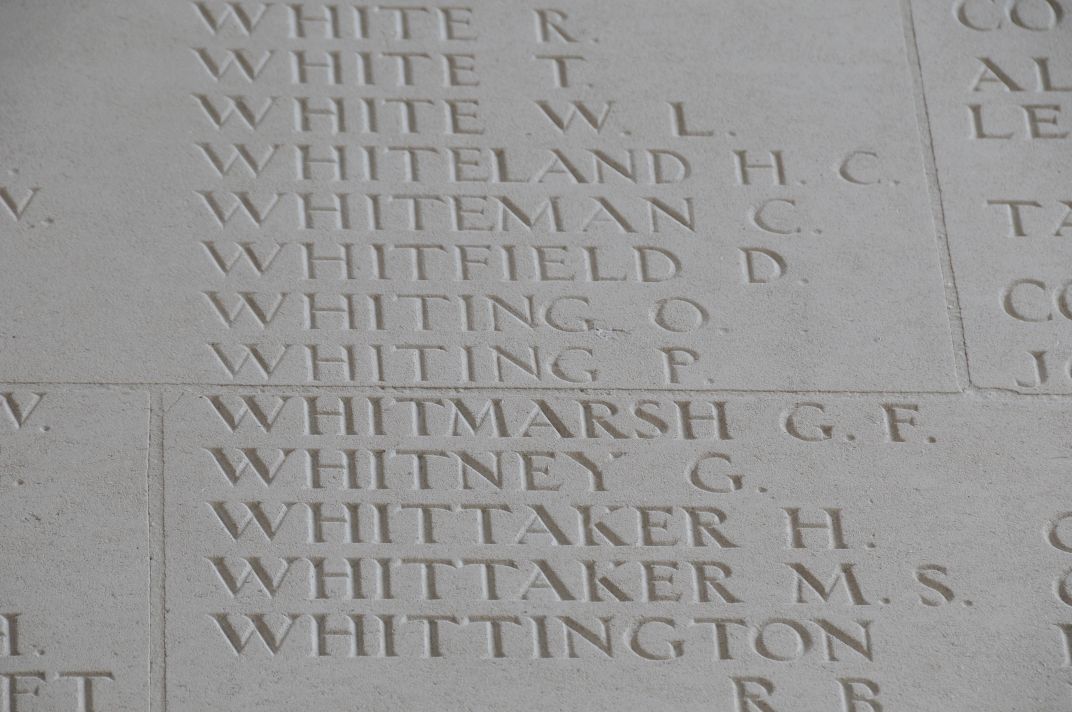 |
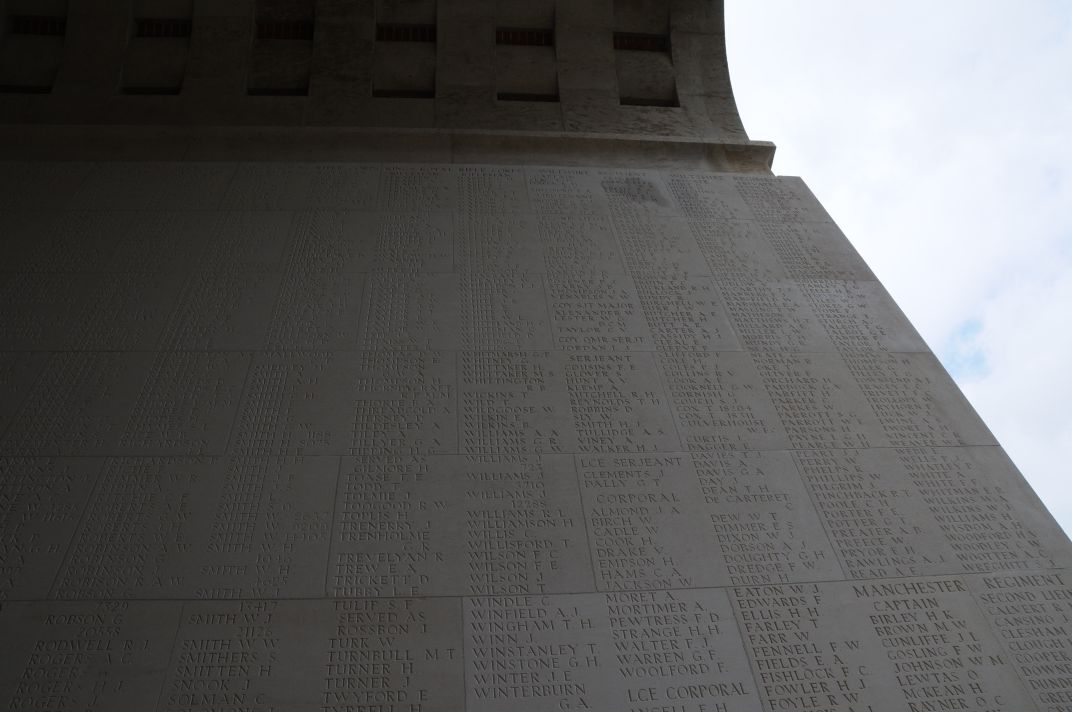 |
|
Bath War Memorial See separate page for details of the Bath War Memorial. Percy Whiting's inscription: |
 |
|
Ascension Church Memorial Percy Whiting is commemorated on the oak tablet in the Ascension Church (see separate page for details of the Ascension Church Memorial). |
 |
Further Information |
Percy Whiting's Uncle who resisted conscriptionWhile many men joined up for military service at the first opportunity, others were more reluctant to go. As well as out-and-out ‘conscientious objectors’, who ran the gauntlet of public humiliation, others were exempted from military service if they could demonstrate that they were indispensable at home. Reasons for an exemption might include being in a business in support of the war effort, or being the sole provider for numerous dependent relatives. Tribunals were held to decide whether applications for exemption were valid and these featured a magistrate arbitrating between the pleas of those affected and representatives of the military; the latter argued in strong terms for men of fighting age doing their duty. You will remember that, in 1911, Percy Whiting was living with his uncle & aunt, John & Gertrude Giles. In May 1916, John Giles appeared before such a tribunal to argue that he should be exempted ‘on business grounds’. At the time, he was a hairdresser and chiropodist, running the ‘Moorland Toilet Saloon’ at 26 Moorland Road (now the Cheong Sing Chinese take-away). His case was adjourned, but by the time it was next brought to the tribunal, it was announced that Giles had withdrawn his appeal and that: ‘...he had decided to answer his country’s call and was joining on June 24th. “Hear, hear”, said several members of the tribunal’. Sure enough, we find John Giles’ attestation papers from 24th
June, when he joined up to the 84th Provisional Battalion (became
the 17th Bn.) of the Hampshire Regiment, which was made up of ‘Home
Service Only’ personnel. So John Giles never had to cross the channel and see
action in the trenches of the Western Front, but his original reticence to join
up is at least somehow corroborated by this designation and the later effects which
even this level of service appear to have had on him. The 17th
Battalion spent time in Whitstable (Kent) and Southwold (Suffolk), but John may
not even have progressed here from his original posting in Herne Bay (Kent).
The sad story which unfolds years later (in 1926) provides further details: |
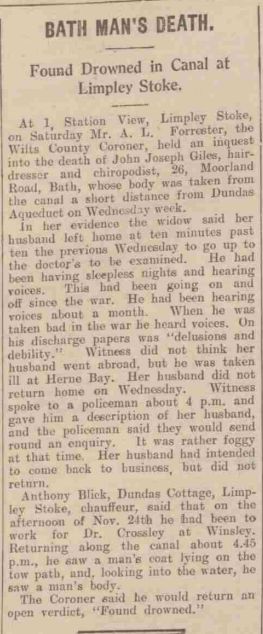 | ||
|
Bath Chronicle & Weekly Gazette 4th December 1926: The psychological effect of military service – even service away from the front – was too much for many men. |
Living relativesIt would be great to hear from any living relatives of Percy Whiting. Owing to his being orphaned as a child and with no surviving siblings, any relatives will be somewhat removed. Please get in touch!If you have any further information on Percy Whiting, or want to suggest corrections / improvements for this page, please use the Contact page to get in touch.All additions and further information will be credited appropriately. AcknowledgementThanks to Mike Sumsion for the photographs of incsriptions at Thiepval. |